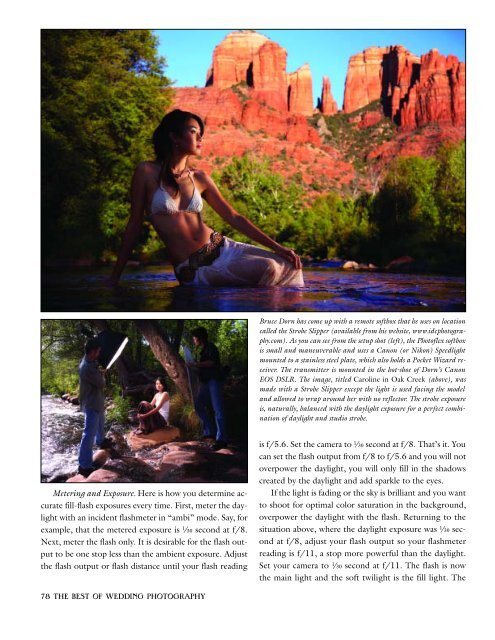The Best of Wedding Photography.pdf - Free
The Best of Wedding Photography.pdf - Free
The Best of Wedding Photography.pdf - Free
Create successful ePaper yourself
Turn your PDF publications into a flip-book with our unique Google optimized e-Paper software.
Metering and Exposure. Here is how you determine accurate<br />
fill-flash exposures every time. First, meter the daylight<br />
with an incident flashmeter in “ambi” mode. Say, for<br />
example, that the metered exposure is 1/30 second at f/8.<br />
Next, meter the flash only. It is desirable for the flash output<br />
to be one stop less than the ambient exposure. Adjust<br />
the flash output or flash distance until your flash reading<br />
78 THE BEST OF WEDDING PHOTOGRAPHY<br />
Bruce Dorn has come up with a remote s<strong>of</strong>tbox that he uses on location<br />
called the Strobe Slipper (available from his website, www.idcphotography.com).<br />
As you can see from the setup shot (left), the Phot<strong>of</strong>lex s<strong>of</strong>tbox<br />
is small and maneuverable and uses a Canon (or Nikon) Speedlight<br />
mounted to a stainless steel plate, which also holds a Pocket Wizard receiver.<br />
<strong>The</strong> transmitter is mounted in the hot-shoe <strong>of</strong> Dorn’s Canon<br />
EOS DSLR. <strong>The</strong> image, titled Caroline in Oak Creek (above), was<br />
made with a Strobe Slipper except the light is used facing the model<br />
and allowed to wrap around her with no reflector. <strong>The</strong> strobe exposure<br />
is, naturally, balanced with the daylight exposure for a perfect combination<br />
<strong>of</strong> daylight and studio strobe.<br />
is f/5.6. Set the camera to 1/30 second at f/8. That’s it. You<br />
can set the flash output from f/8 to f/5.6 and you will not<br />
overpower the daylight, you will only fill in the shadows<br />
created by the daylight and add sparkle to the eyes.<br />
If the light is fading or the sky is brilliant and you want<br />
to shoot for optimal color saturation in the background,<br />
overpower the daylight with the flash. Returning to the<br />
situation above, where the daylight exposure was 1/30 second<br />
at f/8, adjust your flash output so your flashmeter<br />
reading is f/11, a stop more powerful than the daylight.<br />
Set your camera to 1/30 second at f/11. <strong>The</strong> flash is now<br />
the main light and the s<strong>of</strong>t twilight is the fill light. <strong>The</strong>

















